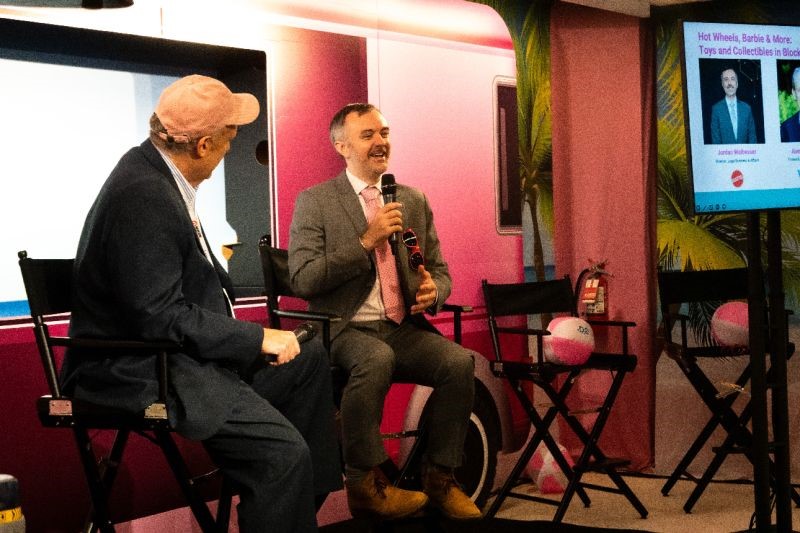Jordan Walbesser, Mattel’s Director of Legal and Business Affairs, recently joined Alan Rechtschaffen, Trustee & Chair, Digital Assets Forum at the Wilson Center at the recent D2 X Advertising Week event to spotlight the exciting intersection of Mattel, the iconic toy company, with blockchain and digital assets technology. The two delved into the innovative use of blockchain, exploring how it creates unique digital assets. The discussion centered on the potential for transforming the collector’s experience and creating a new dimension for engaging with timeless toys and franchises. Barbie, Mattel’s recent epic success of a movie, has elevated the importance of brand consumer loyalty, focusing on what their consumer base loves, which is collecting toys. Mattel started their Web3 journey with virtual digital collectibles through its Hot Wheels Garage and tradeable NFTs. As a public company, Mattel was first to offer this, even before Southerby’s was auctioning off multi-million dollar NFTs. Walbesser said “So we started by issuing those virtual collectibles on the blockchain. And then we wanted to see what people did with them.” The average consumer doesn’t see these are stored on blockchain, but rather focuses on the utility value, which can mean access to unique or very limited physical product, or special access to an event space. The Wilson Center’s focus is on regulatory considerations for digital assets. Alan posed the simple question that many Web2 companies are facing, which is “why blockchain versus a private database?” Walbesser acknowledged that most consumers don’t know the difference, and “the average consumer just wants something that works and wants something that is simple.” A database provides control through an API but has limited value.
“The issue is that (a database) doesn’t allow other people to play with it and to experiment with it. With decentralization, which we’re very excited about, no one owns that ledger. So, if we decided we wanted to discontinue something or we moved in a different direction, or if we invented new things, we could have done it. We could have done it with new brands, new materials, new toys. We would be able to utilize that same ledger or even cooperate with others on that same ledger to magnify and to create some really interesting toyetic opportunities with the collectibles that we have there. So instead of having centralized control, allowing everybody to have access and control over it is really valuable.”
Rechtschaffen: “Can you explain what this idea of not using the term NFT is and how you think about the regulation and what the regulators are doing in terms of the evolution of the technology and the business decisions around that?”
Walbesser: “It’s about branding. And that’s first and foremost…so because of the NFT bubble and some of the bad behavior regulators and Congress have seen, we do want to separate ourselves from that. Our concern from a regulatory perspective is we need to be seen less like a financial instrument as a way to make money and more of a collectible, more of a baseball card. The reason I do that is because I just think it’s a better description of what it actually is. An NFT, technically, it’s an unfungible token. However, it wouldn’t be very fun to say this is my injection molded plastic, miniature figurine. It’s a Barbie doll. Okay, let’s call it something fun and interesting and accessible.”
Rechtschaffen: “How do you think about the idea of moving the play industry into a virtual realm as opposed to children sitting down and playing with physical things? And is there a psychological component of that that Mattel thinks about?”
Walbesser: “It’s a huge top of mind concern for us. Play will never go away. Play is critically important to children’s development. What we’ve seen as a company and as a trend globally is there’s a movement away from physical toys into the virtual space, the gaming space, the mobile space, the console space. There’s a point where there’s new experiences, toyetic or otherwise, that are taking over…and the level of engagement with each other is really valuable, I think, for play, especially in a virtual world where friends, family are much further apart than they used to be.”
Rechtschaffen: “I’m going to press you on a sort of a tough topic, but you were talking about how they sell out instantly. So is there a secondary market and how do you stay away from the financial aspect of this, in treating this as a collectible as opposed to an investment vehicle?”
Walbesser: “There is a secondary market….but it is not something that we expect people to make money on. We’re very clear in our language that this is not something you’re expected to make money off of or receive any value from, it’s just for your own fun as a collector. We’re not saying you have to do this and you’re going to be filthy rich if you do so.”
Rechtschaffen: “What other opportunities are there for corporations aside from somebody who’s making toys or somebody who makes baseball cards to get into the collectible NFT space or are there other use cases of the web3 technology?”
Walbesser: “I’m an optimistic skeptic when it comes to blockchain and web3. I think what’s been missing, the secret sauce is that utility. I’ve seen some interesting things about that decentralized ledger taking the trust out of it. So instead of one company owning it all, you can have a consortium of companies that all use the same ledger to share that information. And then there’s no concerns if one walls that up or goes out of business or there’s changes. It’s always going to be there. So that’s really fascinating to me.” Rechtschaffen summed up by asking Jordan about the advice he would give to the chief marketing officer, the CEO of a company, on how to think about Web3 technology. Walbesser shared these points:
- There’s no right way to play with Web3.
- Become educated to figure out how to capitalize on digital assets and Web3 technology.
- Don’t be afraid of the technology, instead learn the technology and actually play around in the sandbox, because that allows you to think.
- The key is utility, what’s the value to the holder?
- It can’t be a marketing stunt.
- Use it collaboratively.
To watch a short video about Mattel’s Hot Wheels digital collectibles, click here.
See the full session video YouTube Video.



